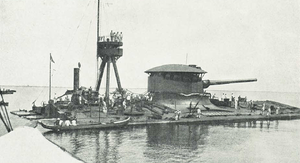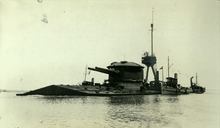Italian monitor Faà di Bruno
 Faà di Bruno | |
| Class overview | |
|---|---|
| Built: | 1916–17 |
| In commission: | 1917–24 |
| Completed: | 1 |
| Scrapped: | 1 |
| History | |
| Name: | Faà di Bruno |
| Namesake: | Emilio Faà di Bruno |
| Builder: | Venice Naval Yard |
| Laid down: | 10 October 1915 |
| Launched: | 30 January 1916 |
| Commissioned: | 1 April 1917 |
| Renamed: | GM 194, 1939 |
| Struck: | 13 November 1924 |
| Reinstated: | 1939 |
| Fate: | scrapped 1944–46 |
| General characteristics | |
| Displacement: | 2,854 tonnes (2,809 long tons; 3,146 short tons) (standard) |
| Length: | 55.56 m (182 ft 3 in) |
| Beam: | 27 m (88 ft 7 in) |
| Draught: | 2.24 m (7 ft 4 in) |
| Installed power: | 465 ihp (347 kW) |
| Propulsion: | 2 shafts, Thornycraft vertical triple-expansion steam engines |
| Speed: | 3.31 knots (6.13 km/h; 3.81 mph) (trials) |
| Complement: | 45 |
| Armament: |
|
| Armor: | |
Faà di Bruno was an Italian monitor built during World War I. Although called a monitor, Faà di Bruno was more of a self-propelled barge with a bow welded on. She was decommissioned in 1924, but returned to service as the floating battery GM 194 at the beginning of World War II. She was towed to Genoa and spent the rest of the war there. She was captured by Germans and entered Kriegsmarine as monitor Biber. She was surrendered in May 1945 and scrapped after World War II.
Development and description
Faà di Bruno was built when Cannone navali da 381/40 guns from the Francesco Caracciolo-class battleships became available after their construction was suspended in 1916. Her guns were built by Ansaldo-Schneider and originally destined for the Cristoforo Colombo. Her navigation bridge was placed on a prominent tripod abaft the turret. She displaced 2,584 long tons (2,625 t), with a length between perpendiculars of 55.56 meters (182 ft 3 in), a beam of 27 meters (88 ft 7 in) and a draft of 2.24 meters (7 ft 4 in). Faà di Bruno was powered by two surplus Thornycroft vertical triple-expansion steam engines from discarded torpedo boats. One Kess boilers provided enough steam to power a total of 465 indicated horsepower (347 kW) between them. On sea trials the ship reached a maximum speed of 3.31 knots (6.1 km/h; 3.8 mph), but her maximum speed in regular service was about 2.5 knots (4.6 km/h; 2.9 mph).[1]
Her hull was surrounded by a concrete cofferdam 2.9 meters (9 ft 6 in) thick. Her deck armor had a thickness of 40 millimeters (1.6 in).[2] It sloped down from the center and had a peak of 7 feet (2.1 m).[1] Her guns were mounted in an open-topped turret covered in a curious-looking armored dome. The turret sides had a total thickness of 110 millimeters (4.3 in) and its barbette had armor 60 millimeters (2.4 in) thick.[2]
Her main guns could elevate 15° and her turret could traverse 30° to either side.[1] They fired an 884 kg (1,949 lb) armor-piercing shell at a muzzle velocity of 700 m/s (2,297 ft/s) to a range of 27,300 m (89,567 ft) at maximum elevation.[3] She was fitted with four 76.2 mm (3.00 in) 40-caliber Ansaldo anti-aircraft guns. They fired a 6.5 kilograms (14 lb) high explosive shell at a muzzle velocity of 680 m/s (2,231 ft/s) to a range of 10,000 meters (11,000 yd) at a rate of fifteen rounds per minute.[4] She also mounted two water-cooled 40 mm (1.6 in)/39 Vickers-Terni 1915/1917 light AA guns. Their shells were set to self-destruct at a range of 4,475 yards (4,092 m).[5]
Service

Faà di Bruno was laid down on 10 October 1915, even before the battleships were officially suspended, by the Venice Naval Yard to a design by Rear Admiral Giuseppe Rota. The ship was launched on 30 January 1916 and commissioned on 1 April 1917. Her first action came during the 11th Battle of the Isonzo in August 1917. She, in company with the Italian monitor Alfredo Cappellini and the British monitors Earl of Peterborough and Sir Thomas Picton, bombarded Austrian positions with little noticeable effect. She was driven ashore in a storm in November 1917,[6] but was not salvaged for almost a full year.[1]
She was stricken from the Navy List on 13 November 1924, but was placed back into service at the beginning of World War II as the floating battery GM 194. She was towed from Venice to Genoa, where she remained for the rest of the war.[7] When the British bombarded Genoa on 9 February 1941 she could not return fire because one of the first British shells damaged the cables that provided electrical power to her guns. She was captured by Germans after the Italian capitulation and entered Kriegsmarine service as the monitor Biber, receiving extensive modification that increased ship length from 56 to 130m. She was surrendered in May 1945 and scrapped after World War II.[1]
References
- 1 2 3 4 5 Trawick and Wiltering, pp. 297–98
- 1 2 Conway's, p. 288
- ↑ "Italian 381 mm/40 (15") Model 1914". 9 October 2006. Retrieved 18 November 2009.
- ↑ "British 12-pdr [3"/40 (7.62 cm)] 12cwt QF Marks I, II and V --- Japanese 3"/40 (7.62 cm) Elswick Pattern N and Vickers Mark Z 3"/40 (7.62 cm) 41st Year Type 8 cm/40 (3") 41st Year Type --- Italian 3"/40 (7.62 cm) Armstrong 1916 and 1917 76.2 mm/40 (3") Ansaldo 1916 and 1917". 21 November 2006. Retrieved 20 November 2009.
- ↑ "British 2-pdr [4 cm/39 (1.575")] Mark II --- Italian 40 mm/39 (1.575") Vickers-Terni 1915/1917 --- Russian 40 mm/39 (1.575") Vickers Automatic Model 1914". 2 March 2007. Retrieved 20 November 2009.
- ↑ Buxton, Ian (2008). Big Gun Monitors: Design, Construction and Operations 1914–1945 (2nd revised and expanded ed.). Annapolis, MD: Naval Institute Press. p. 71. ISBN 978-1-59114-045-0.
- ↑ Gardiner, Robert, ed. (1992). The Eclipse of the Big Gun. Conway's History of the Ship. London: Conway Maritime Press. p. 74. ISBN 0-85177-566-7.
Bibliography
- Clerici, Carlo; Robbins, Charles B.; Flocchini, Alfredo (1999). "The 15" (381mm)/40 Guns of the Francesco Caracciolo Class Battleships". Warship International. Toledo, OH: International Naval Research Organization. 36 (2): 151–157. ISSN 0043-0374.
- Fraccaroli, Aldo (1970). Italian Warships of World War I. London: Ian Allan. ISBN 978-0-7110-0105-3.
- Gardiner, Robert; Gray, Randal, eds. (1984). Conway's All the World's Fighting Ships: 1906-1922. Annapolis: Naval Institute Press. ISBN 0-85177-245-5.
- Trawick, Henry P.; Wiltering, John H. Jr. (2010). "Italian Monitor Faa di Bruno". Warship International. Toldeo, OH: International Navy Research Organization. XLVII (4): 297–298. ISSN 0043-0374.